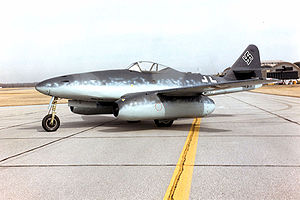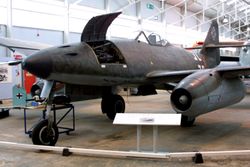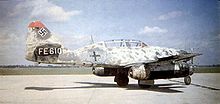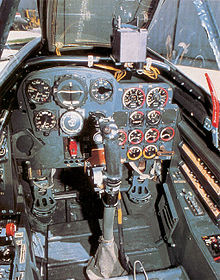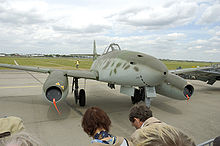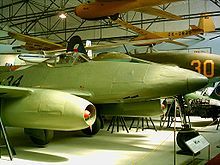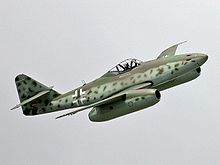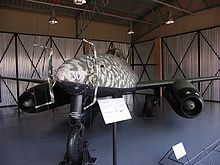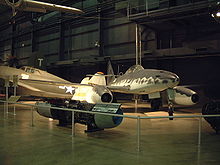- Messerschmitt Me 262
-
Me 262 Schwalbe Messerschmitt Me 262A Role Fighter aircraft Manufacturer Messerschmitt First flight 18 April 1941 with piston engine
18 July 1942 with jet engines[1]Introduction April 1944[2][3] Retired 1945, Germany
1951, Czechoslovakia[4]Primary users Luftwaffe
Czechoslovak Air Force (S-92)Number built 1,430 The Messerschmitt Me 262 Schwalbe ("Swallow") was the world's first operational jet-powered fighter aircraft.[5] Design work started before World War II began, but engine problems prevented the aircraft from attaining operational status with the Luftwaffe until mid-1944. Compared with Allied fighters of its day, including the jet-powered Gloster Meteor, it was much faster and better armed.[6]
In combat, when properly flown, it proved difficult to counter due to its speed. Me 262 pilots claimed a total of 542 Allied kills[7] (although higher claims are sometimes made)[Notes 1] against the loss of about 100 Me 262s.[citation needed] The design was pressed into a variety of roles, including light bomber, reconnaissance and even experimental night fighter versions.
The Me 262 was one of the most advanced aviation designs in operational use during World War II.[9] The Allies countered its potential effectiveness in the air by relentlessly attacking the aircraft on the ground, or while they were taking off or landing. Maintenance problems and a lack of fuel during the deteriorating late-war situation also reduced the effectiveness of the aircraft as a fighting force. In the end, the Me 262 had a negligible impact on the course of the war due to its late introduction and the small numbers that were deployed in operational service.[10]
The Me 262 influenced the designs of post-war aircraft such as the North American F-86 Sabre and Boeing B-47 Stratojet.[9]
Contents
Design and development
The Me 262 was already being developed as Projekt 1065 (P.1065) before the start of World War II. Plans were first drawn up in April 1939, and the original design was very similar to the plane that eventually entered service. The progression of the original design into service was delayed greatly by technical issues involving the new jet engines. Funding for the jet program was also initially lacking as many high-ranking officials thought the war could easily be won with conventional aircraft.[11]
Among those were: Hermann Göring, head of the Luftwaffe, who cut the engine development program to just 35 engineers in February 1940; Willy Messerschmitt, who desired to maintain mass production of the Bf 109 and the projected Me 209; and Major General Adolf Galland, who supported Messerschmitt through the early development years, flying the Me 262 himself on 22 April 1943. By that time, problems with engine development had slowed production of the aircraft considerably.[12]
The project aerodynamicist on the design of the Me 262 was Ludwig Bölkow, later a prominent figure in the post-World War II development of the German aircraft industry. He initially designed the wing using NACA airfoils modified with an elliptical nose section.[13] Later in the design process, these were changed to AVL derivatives of NACA airfoils, the NACA 00011-0.825-35 being used at the root and the NACA 00009-1.1-40 at the tip.[14]
The elliptical nose derivatives of the NACA airfoils were used on the horizontal and vertical tail surfaces. Wings were single-spar cantilever construction, with stressed skins, varying from 3 mm (0.12 in) thick at the root to 1 mm (0.039 in) at the tip.[15] The wings were fastened to the fuselage at four points, using a pair of 20 mm (0.79 in) and forty-two 8 mm (0.31 in) bolts.[16]
In mid-1943, Adolf Hitler envisioned the Me 262 as an offensive ground-attack/bomber rather than a defensive interceptor. The configuration of a high speed, light payload Schnellbomber ("Fast Bomber") was intended to penetrate enemy airspace during the expected Allied invasion of France. His edict resulted in the development of (and concentration on) the Sturmvogel variant. It is debatable to what extent Hitler's interference extended the delay in bringing the Schwalbe into operation.[17][18]
Albert Speer, then Minister of Armaments and War Production, claimed in his memoirs that Hitler originally had blocked mass production of the Me 262 before agreeing in early 1944. He rejected arguments that the aircraft would be more effective as a fighter against Allied bombers then destroying large parts of Germany, and wanted it as a bomber for revenge attacks. According to Speer, Hitler felt its superior speed compared to other fighters of the era meant it could not be attacked and so preferred it for high altitude straight flying.[19]
Although the Me 262 is often referred to as a "swept wing" design, the production Me 262 had a leading edge sweep of only 18.5°, too slight to achieve any significant advantage in increasing the critical Mach number.[20] Sweep was added after the initial design of the aircraft, when the engines proved to be heavier than originally expected, primarily to position the center of lift properly relative to the centre of mass. On 1 March 1940, instead of moving the wing forward on its mount, the outer wing was repositioned slightly aft; the trailing edge of the mid-section of the wing remained unswept.[21] Based on data from the AVA Göttingen and wind tunnel results, the middle section's leading edge was later swept to the same angle as the outer panels.[22]
Test flights
The first test flights began on 18 April 1941, with the Me 262 V1 example, bearing its Stammkennzeichen radio code letters of PC+UA, but since its intended BMW 003 turbojets were not ready for fitting, a conventional Junkers Jumo 210 engine was mounted in the V1 prototype's nose, driving a propeller, to test the Me 262 V1 airframe. When the BMW 003 engines were finally installed, the Jumo was retained for safety, which proved wise as both 003s failed during the first flight and the pilot had to land using the nose-mounted engine alone.[1] The BMW 003s were discovered to be subject to catastrophic failure due to the propwash entering the intakes during operation and they were permanently removed from the program in favor of the relatively reliable Junkers Jumo 004.
The V3 third prototype airframe, with the code PC+UC, became a true "jet" when it flew on 18 July 1942 in Leipheim near Günzburg, Germany, piloted by Fritz Wendel.[25] This was almost nine months ahead of the British Gloster Meteor's first flight on 5 March 1943. The conventional gear — producing a pronounced tail-down attitude on the ground — of the Me 262 V3 caused its jet exhaust to deflect off the runway, with the wing's turbulence negating the effects of the elevators, and the first takeoff attempt was cut short.[26]
On the second attempt, Wendel solved the problem by tapping the aircraft's brakes at takeoff speed, lifting the horizontal tail out of the wing's turbulence.[27] The first four prototypes (V1-V4) were built with this configuration. Changing to a tricycle arrangement,[28] initially a fixed undercarriage on the "V5" fifth prototype, then fully retractable on the sixth (V6, with Stammkennzeichen code VI+AA) and succeeding aircraft, corrected this problem.
Test flights continued over the next year, but engine problems continued to plague the project, the Jumo 004 being only marginally more reliable than the BMW 003. Airframe modifications were complete by 1942, but hampered by the lack of engines, serial production did not begin until 1944, but deliveries were low, with 28 Me 262s in June, 59 in July, but only 20 in August.[9] This delay in engine availability was in part due to the shortage of strategic materials, especially metals and alloys able to handle the extreme temperatures produced by the jet engine.
Even when the engines were completed, they had an expected operational lifetime of approximately 50 continuous flight hours; most 004s lasted just 12 hours, even with adequate maintenance. A pilot familiar with the Me 262 and its engines could expect approximately 20–25 hours of life from the 004s. Changing a 004 engine was intended to require three hours, but this typically took eight to nine due to poorly made parts and inadequate training of ground crews.
Turbojet engines have less thrust at low speed than propellers, and as a result, low-speed acceleration is relatively poor. It was more noticeable for the Me 262 as early jet engines (before the invention of afterburners) responded slowly to throttle changes. The introduction of a primitive autothrottle late in the war only helped slightly. Conversely, the higher power of jet engines at higher speeds meant the Me 262 enjoyed a much higher rate of climb. Used tactically, this gave the jet fighter an even greater speed advantage in climb rate than level flight at top speed.
With one engine out, the Me 262 still flew well, with speeds of 450–500 km/h (280–310 mph), but pilots were warned never to fly slower than 300 km/h (190 mph) on one engine, as the asymmetrical thrust would cause serious problems.
Operationally, carrying 2,000 l (440 imp gal; 530 US gal) of fuel (in two 900 l (200 imp gal; 240 US gal) tanks, one each fore and aft the cockpit, and a 200 l (44 imp gal; 53 US gal) tank beneath),[29] the Me 262 had an endurance of 60 to 90 minutes. Fuel was usually brown coal-derived J2, with the option of diesel oil or a mixture of oil and high octane B4 aviation petrol.[30] Consumption was double the usual for a twin-engine Luftwaffe aircraft, so a low-fuel warning came on when levels fell below 250 l (55 imp gal; 66 US gal).[31]
Unit cost for an Me 262 airframe, less engines, armament, and electronics, was RM87,400.[32] (By comparison, a new Volkswagen Type 1 was priced at RM990.)[33]To build one airframe took around 6,400 man-hours.[34]
Operational history
On 19 April 1944, Erprobungskommando 262 was formed at Lechfeld just south of Augsburg, Bavaria as a test unit (Jäger Erprobungskommando Thierfelder, commanded by Hauptmann Werner Thierfelder)[3][35] to introduce the 262 into service and train a core of pilots to fly it. On 26 July 1944, Leutnant Alfred Schreiber with the 262 A-1a W.Nr. 130 017 damaged a Mosquito reconnaissance aircraft of No. 540 Squadron RAF PR Squadron, which was allegedly lost in a crash landing upon landing at an air base in Italy.[36] Other sources state the aircraft was damaged during evasive manoeuvres and escaped.[37]
It was the first victory for a turbojet fighter aircraft in aviation history.[38] Major Walter Nowotny was assigned as commander after the death of Thierfelder in July 1944, and the unit redesignated Kommando Nowotny. Essentially a trials and development unit, it holds the distinction of having mounted the world's first jet fighter operations. Trials continued slowly, with initial operational missions against the Allies in August 1944 allegedly downing 19 Allied aircraft for six Me 262s lost, although these claims have never been verified by cross-checking with USAAF records. The RAF Museum holds no intelligence reports of RAF aircraft engaging in combat with Me 262s in August, although there is a report of an unarmed encounter between an Me 262 and a Mosquito.[39]
Despite orders to stay grounded, Nowotny chose to fly a mission against an enemy bomber formation flying some 30,000 feet above, on 8 November 1944. He claimed two P-51Ds destroyed before suffering engine failure at high altitude.[40] Then, while diving and trying desperately to restart his engines, he was attacked and forced to bail out by other Mustangs. Some[who?] U.S. historians proposed Nowotny's victor was P-51D pilot Lt. Robert W Stevens of the 364th Fighter Group.[41] According to other sources, he was shot down and killed by First Lieutenant Edward "Buddy" Haydon of the 357th Fighter Group and Captain Ernest "Feeb" Fiebelkorn of the 20th Fighter Group, both USAAF.[citation needed]
Actually, the exact circumstances surrounding the death of Walter Nowotny remain uncertain to this day. It is also possible he was hit by "friendly" flak.[41] The Kommando was then withdrawn for further training and a revision of combat tactics to optimise the 262's strengths.
By January 1945, Jagdgeschwader 7 (JG 7) had been formed as a pure jet fighter wing, although it would be several weeks before it was operational. In the meantime, a bomber unit – I Gruppe, Kampfgeschwader 54 (KG 54) – had re-equipped with the Me 262 A-2a fighter-bomber for use in a ground-attack role. However, the unit lost 12 jets in action in two weeks for minimal returns.
Jagdverband 44 (JV 44) was another Me 262 fighter unit, of Staffel (squadron) size given the low numbers of available personnel, formed in February 1945 by Lieutenant General Adolf Galland, who had recently been dismissed as Inspector of Fighters. Galland was able to draw into the unit many of the most experienced and decorated Luftwaffe fighter pilots from other units grounded by lack of fuel.
During March, Me 262 fighter units were able, for the first time, to mount large scale attacks on Allied bomber formations. On 18 March 1945, 37 Me 262s of JG 7 intercepted a force of 1,221 bombers and 632 escorting fighters. They shot down 12 bombers and one fighter for the loss of three Me 262s. Although a 4:1 ratio was exactly what the Luftwaffe would have needed to make an impact on the war, the absolute scale of their success was minor, as it represented only one per cent of the attacking force. In 1943 and early 1944, the USAAF had been able to keep up offensive operations despite loss ratios of 5% and more, and the few available Me 262s could not inflict sufficient losses to hamper their operations.
Several two-seat trainer variants of the Me 262, the Me 262 B-1a, had been adapted through the Umrüst-Bausatz 1 factory refit package as night fighters, complete with on-board Wilde Sau methods, rather than AI radar-controlled interception. As the two-seat trainer was largely unavailable, many pilots had to make their first flight in a jet in a single-seater without an instructor.
Despite its deficiencies, the Me 262 clearly signaled the beginning of the end of piston-engined aircraft as effective fighting machines. Once airborne, it could accelerate to speeds well over 800 km/h (500 mph), over 150 km/h (90 mph) faster than any Allied fighter operational in the European Theater of Operations.
The Me 262's top ace[Notes 2] was probably Hauptmann Franz Schall with 17 kills which included six four-engine bombers and 10 P-51 Mustang fighters, although night fighter ace Oberleutnant Kurt Welter claimed 25 Mosquitos and two four-engine bombers shot down by night and two further Mosquitos by day flying the Me 262. Most of Welter's claimed night kills were achieved in standard radar-less aircraft, even though Welter had tested a prototype Me 262 fitted with FuG 218 Neptun radar. Another candidate for top ace on the aircraft was Oberstleutnant Heinrich Bär, who claimed 16 enemy aircraft while flying the Me 262.
Anti-bomber tactics
The Me 262 was so fast that new tactics had to be devised to attack American bombers. In the head-on attack, the closing speed, of about 350 yd per second (320 m), was too high for accurate shooting. Even from astern, the closing speed was too great for the short-ranged 30 mm cannon to be used to maximum effect. Therefore, a roller-coaster attack was devised. The 262s approached from astern and about 6,000 ft higher (1,800 m) than the bombers. From about 3 mi behind (4.8 km), they went into a shallow dive that took them through the escort fighters with little risk of interception. When they were about 1 mi astern (1.6 km) and 1,500 feet (460 m) below the bombers, they pulled up sharply to reduce their excess speed. On levelling off, they were 1,000 yd astern (0.91 km) and overtaking the bombers at about 100 mph (160 km/h), well placed to attack them.[42]
Since 30 mm cannon were not accurate above 650 yd (590 m), and since it was necessary to break off at 200 yd (180 m) to avoid colliding with the target, Me 262 pilots would normally commence firing at 550 yd (500 m).[43] Allied bomber gunners found their electric gun turrets had problems tracking the jets. Target acquisition was difficult because the jets closed into firing range quickly and remained in firing position only briefly, using their standard attack profile which proved to be more effective.
A Me 262 with R4M under wing rockets on display at the Technikmuseum Speyer, Germany.
Captain Eric Brown, Chief Naval Test Pilot and C.O. Captured Enemy Aircraft Flight Royal Aircraft Establishment, who tested the Me 262 noted: "This was a Blitzkrieg aircraft. You whack in at your bomber. It was never meant to be a dogfighter, it was meant to be a destroyer of bombers… The great problem with it was it did not have dive brakes. For example, if you want to fight and destroy a B-17, you come in on a dive. The 30mm cannon were not so accurate above 650 yards. So you normally came in at 600 yards and would open fire on your B-17. And your closing speed was still high and since you had to break away at 200 yards to avoid a collision, you only had two seconds firing time. Now, in two seconds, you can’t sight. You can fire randomly and hope for the best. If you want to sight and fire, you need to double that time to four seconds. And with dive brakes, you could have done that."[43]
Eventually, new combat tactics were developed to counter the Allied bombers' defences. Me 262s, equipped with R4M rockets, would approach from the side of a bomber formation, where their silhouettes were widest, and while still out of range of the bombers machine guns, fire a salvo of rockets. The Hexogen filled warhead of only one or two of these rockets was capable of downing even the famously rugged B-17 Flying Fortress; a strike on an enemy aircraft meant its total annihilation.[44]
Although this tactic was effective, it came too late to have a real effect on the war, and only small numbers of Me 262s were actually equipped with the rocket packs.[45] Most of those so equipped were Me 262A-1as, members of Jagdgeschwader 7.[46] This method of attacking bombers became the standard until the invention and mass deployment of guided missiles. Some nicknamed this tactic the "Luftwaffe's Wolf Pack", as the fighters would often make runs in groups of two or three, fire their rockets, then return to base.
On 1 September 1944, USAAF General Carl Spaatz expressed the fear that if greater numbers of German jets appeared, they could inflict losses heavy enough to force cancellation of the Allied bombing offensive by daylight.
Counter-jet tactics
The Me 262 was difficult for its opponents to counter, once in the air, because of its high speed and rate of climb which made it extremely hard to intercept. As with all other early jets, the Me 262's engines did not provide a lot of thrust at low air speeds (a key criterion for good turn performance), and throttle response was slow. Another disadvantage shared by all early jet engines was the relatively high risk of flameout if the throttle was used too aggressively (such as was common in a dogfight). Pilots were therefore instructed to operate the throttle gently and avoid quick changes in setting. Later in the war, an automatic throttle regulator was introduced to try to solve this, but it only partly alleviated the problem. On the plus side, thrust at high speed was much greater than on propeller-driven aircraft.
Furthermore the Me 262 had, by contemporary standards, quite a high wing loading (60.2 lbs/ft2, 294.0 kg/m2) and its turn radius at low speeds was therefore correspondingly wide. This coupled with the slow throttle response and high chance of a flameout, resulted in Me 262 pilots being told to avoid low speed dogfights with the Allied piston engine fighters. The high speed of the Me 262 also presented problems when engaging enemy aircraft, the high speed convergence allowing Me 262 pilots little time to line up their targets or acquire the appropriate amount of deflection. This is a problem which faces any aircraft which is approaching another one from behind at much higher speed, as the slower going aircraft in front will always be able to pull a tighter turn, forcing the faster aircraft to overshoot. This was a problem the Me 262 faced a lot, as its cruising speed alone was up to 200 km/h (120 mph) faster than that of any piston-engine fighter of the period. Oberst Johannes Steinhoff experienced this problem when he encountered a dozen Russian fighters early in 1945, the much higher speed of his Me 262 making it extremely difficult for him to get his guns on the small Russian fighters. He recalled:
I passed one that looked as if it was hanging motionless in the air (I am too fast!). The one above me went into a steep right-hand turn, his pale blue underside standing out against the purple sky. Another banked right in front of the Me's nose. Violent jolt as I flew through his airscrew eddies. Maybe a wing's length away. That one in the gentle left-hand curve! Swing her round. I was coming from underneath, eye glued to the sight (pull her tighter!). A throbbing in the wings as my cannon pounded briefly. Missed him. Way behind his tail. It was exasperating. I would never be able to shoot one down like this. They were like a sack of fleas. A prick of doubt: is this really such a good fighter? Could one in fact, successfully attack a group of erratically banking fighters with the Me 262?[47]
Luftwaffe pilots did however eventually learn how to handle the Me 262's higher speed, and the Me 262 soon proved a formidable air superiority fighter, with pilots such as Franz Schall managing to shoot down 12 enemy fighters in the Me 262, 10 of them American P-51 Mustangs. Other notable Me 262 aces included Georg-Peter Eder, also with 12 enemy fighters to his credit (including 9 P-51s), Walther Dahl with 11 (including three La-7s and six P-51s) and Heinz-Helmut Baudach with 6 (including 1 Spitfire and 2 P-51s) amongst many others.
Despite its high wing loading and lack of low-speed thrust, pilots soon learned that the Me 262 was quite maneuverable, especially if attention was drawn to its effective maneuvering speeds. The controls were light and effective right up to the maximum permissible speed and perfectly harmonized. The addition of full span leading edge slats, in three unconnected sections on each wing,[48] helped increase the overall lift produced by the wing by as much as 25 to 35% in tight turns or at low speeds, greatly improving the aircraft's turn performance as well as its landing and take off characteristics.[49] (The slats lowered the stalling speed of the aircraft to a respectable 160 to 170 km/h (86 to 92 kn; 99 to 110 mph) depending on load out. They deployed automatically below 300 km/h (160 kn; 190 mph) on takeoff or landing, where the innermost (between fuselage and nacelle) was normally deployed, and at 450 km/h (240 kn; 280 mph) in turn or climb.)[50] And as many pilots soon found out, the Me 262's clean design also meant that it, like all jets, held its speed in tight turns much better than conventional propeller driven fighters, which was a great potential advantage in a dogfight as it meant better energy retention in maneuvers.[51] Luftwaffe test pilot and flight instructor Hans Fey stated, "The 262 will turn much better at high than at slow speeds, and due to its clean design, will keep its speed in tight turns much longer than conventional type aircraft."[52]
Too fast to catch for the escorting Allied fighters, the Me 262s were almost impossible to head off. [Notes 3] As a result, Me 262 pilots were relatively safe from the Allied fighters, as long as they did not allow themselves to get drawn into low-speed turning contests and saved their maneuvering for higher speeds. Combating the Allied fighters could be effectively done the same way as the U.S. fighters fought the more nimble, but slower, Japanese fighters in the Pacific.
Allied pilots soon found the only reliable way of dealing with the jets, as with the even faster Me 163 Komet rocket fighters, was to attack them on the ground and during takeoff or landing. Luftwaffe airfields identified as jet bases were frequently bombed by medium bombers, and Allied fighters patrolled over the fields to attack jets trying to land. The Luftwaffe countered by installing extensive flak alleys of anti-aircraft guns along the approach lines in order to protect the Me 262s from the ground, and providing top cover during the jets' takeoff and landing with the most advanced Luftwaffe single-engined fighters, the Focke-Wulf Fw 190D and (just becoming available in 1945) Focke-Wulf Ta 152H. Nevertheless, in March–April 1945, Allied fighter patrol patterns over Me 262 airfields resulted in numerous losses of jets and serious attrition of the force.
High speed research
Willy Messerschmitt regarded the Me 262 as only an interim type when it went into production.
Swept wings had been proposed as early as 1935 by Adolf Busemann, and Messerschmitt had researched the topic from 1940. In April 1941, he proposed fitting a 35° swept wing (Pfeilflügel II, literally "arrow wing II") to the Me 262,[54] the same wing sweep angle that would later be used on both the American F-86 Sabre and Soviet MiG-15 Fagot fighter jets. Though this was not implemented, he continued with the projected HG II and HG III (Hochgeschwindigkeit, "high speed") derivatives in 1944, which were designed with a 35° and 45° wing sweep, respectively.[55]
Interest in high-speed flight, which led him to initiate work on swept wings starting in 1940, is evident from the advanced developments Messerschmitt had on his drawing board in 1944. While the Me 262 HG I actually flight tested in 1944 had only small changes compared to combat aircraft, most notably a low-profile canopy (tried as the Rennkabine (literally "racing cabin") on the Me 262 V9 prototype for a short time) to reduce drag, the HG II and HG III designs were far more radical. The projected HG II combined the low-drag canopy with a 35° wing sweep and a butterfly tail. The HG III had a conventional tail, but a 45° wing sweep and turbines embedded in the wing roots.[56]
Messerschmitt also conducted a series of flight tests with the series production Me 262. In dive tests, it was determined that the Me 262 went out of control in a dive at Mach 0.86, and that higher Mach numbers would lead to a nose-down trim that could not be countered by the pilot. The resulting steepening of the dive would lead to even higher speeds and disintegration of the airframe due to excessive negative g loads.
The HG series of Me 262 derivatives was estimated to be capable of reaching transonic Mach numbers in level flight, with the top speed of the HG III being projected as Mach 0.96 at 6,000 m (19,690 ft) altitude. Despite the necessity to gain experience in high-speed flight for the HG II and III designs, Messerschmitt undertook no attempts to exceed the Mach 0.86 limit for the Me 262.
After the war, the Royal Aircraft Establishment, at that time one of the leading institutions in high-speed research, re-tested the Me 262 to help with British attempts at exceeding Mach 1. The RAE achieved speeds of up to Mach 0.84 and confirmed the results from the Messerschmitt dive tests. Similar tests were run by the Soviets. No attempts were made to exceed the Mach limit established by Messerschmitt.
After Willy Messerschmitt's death, the former Me 262 pilot Hans Guido Mutke claimed to be the first person to exceed Mach 1, on 9 April 1945 in a Me 262 in a "straight-down" 90° dive. This claim is disputed because it is only based on Mutke's memory of the incident, which recalls effects other Me 262 pilots observed below the speed of sound at high indicated airspeed, but with no altitude reading required to determine the actual speed. Furthermore, the pitot tube used to measure airspeed in aircraft can give falsely elevated readings as the pressure builds up inside the tube at high speeds. Finally, the Me 262 wing had only a slight sweep incorporated for trim (center of gravity) reasons and likely would have suffered structural failure due to divergence at high transonic speeds. One airframe (Me 262 HG1 V9, Werknummer 130 004, with Stammkennzeichen of VI+AD[57]) was prepared with the low-profile Rennkabine racing canopy and may have achieved an unofficial record speed for a turbojet-powered aircraft of 975 km/h (606 mph), altitude unspecified.[58]
Production
While Germany was bombed intensively, production of the Me 262 was dispersed into low-profile production facilities, sometimes little more than clearings in the forests of Germany and occupied countries. Through the end of February to the end of March 1945, approximately 60 Me 262s were destroyed in attacks on Obertraubling and 30 at Leipheim[59] (the Neuberg jet plant was bombed on 19 March.)[60] Large, heavily protected underground factories were constructed to take up production of the Me 262, safe from bomb attacks, but the war ended before they could be completed. At B8 Bergkristall-Esche II at St. Georgen/Gusen, Austria, forced labourers of Concentration Camp Gusen II produced fully equipped fuselages for the Me 262 at a monthly rate of 450 units on large assembly lines from early 1945.[61]
Wings for the Me 262 were produced in Germany's oldest motorway tunnel at Engelberg to the west of Stuttgart. In the end, slightly over 1,400 Me 262s of all versions were produced. As few as 200 Me 262s made it to combat units due to fuel shortages, pilot shortages, and the lack of airfields that could support the Me 262.[citation needed]
Postwar history
After the end of the war, the Me 262 and other advanced German technologies were quickly swept up by the Americans (as part of the USAAF's Operation Lusty), British, and Soviets. Many Me 262s were found in readily-repairable condition and were confiscated.
During testing, the Me 262 was found to have advantages over the early models of the Gloster Meteor. It was faster, had better cockpit visibility to the sides and rear (mostly due to the canopy frame and the discoloration caused by the plastics used in the Meteor's construction), and was a superior gun platform, as the early Meteors had a tendency to snake at high speed and exhibited "weak" aileron response.[62] The Me 262 did have a shorter combat range than the Meteor.
The USAAF compared the P-80 Shooting Star and Me 262 concluding, "Despite a difference in gross weight of nearly 2,000 lb (900 kg), the Me 262 was superior to the P-80 in acceleration, speed and approximately the same in climb performance. The Me 262 apparently has a higher critical Mach number, from a drag standpoint, than any current Army Air Force fighter."[63]
The Army Air Force also tested an example of the Me 262A-1a/U3 (US flight evaluation serial FE-4012), an unarmed photo reconnaissance version, which was fitted with a fighter nose and given an overall smooth finish. It was used for performance comparisons against the P-80. During testing between May and August 1946, the aircraft completed eight flights, lasting four hours and 40 minutes. Testing was discontinued after four engine changes were required during the course of the tests, culminating in two single-engine landings.[64]
These aircraft were extensively studied, aiding development of early U.S. and Soviet jet fighters. The F-86, designed by engineer Edgar Schmued, used a slat design based on the Me 262's.[65]
The Czechoslovak aircraft industry continued to produce single-seat (Avia S-92) and two-seat (Avia CS-92) variants of the Me 262 after World War II. From August 1946, a total of nine S-92s and three two-seater CS-92s were completed and test flown. They were introduced in 1947 and in 1950 were supplied to the 5th Fighter Squadron, becoming the first jet fighters to serve in the Czechoslovak Air Force. These were kept flying until 1951[4] when they were replaced in service by more advanced jet fighters of Soviet origin. Both versions are on display at the Prague Aviation museum in Kbely.
Flyable reproductions
In January 2003, the American Me 262 Project, based in Everett, Washington, completed flight testing to allow for delivery of near-exact reproductions of several versions of the Me 262 including at least two B-1c two-seater variants, one A-1c single seater and two "convertibles" that could be switched between the A-1c and B-1c configurations. All are powered by General Electric J85 engines and feature additional safety features, such as upgraded brakes and strengthened landing gear. The "c" suffix refers to the new J85 powerplant and has been informally assigned with the approval of the Messerschmitt Foundation in Germany[citation needed] (the Werk Number of the reproductions picked up where the last wartime produced Me 262 left off – a continuous airframe serial number run with a 50 year production break).
Flight testing of the first newly manufactured Me 262 A-1c (single-seat) variant (Werk Number 501244) was completed in August 2005. The first of these machines (Werk Number 501241) went to a private owner in the southwestern United States, while the second (Werk Number 501244) was delivered to the Messerschmitt Foundation at Manching, Germany. This aircraft conducted a private test flight in late April 2006, and made its public debut in May at the ILA 2006. The new Me 262 flew during the public flight demonstrations.[66] Me 262 Werk Number 501241 was delivered to the Collings Foundation as White 1 of JG 7. This aircraft will be offering ride-along flights starting in 2008.[67] The third replica, a non-flyable Me 262 A-1c, was delivered to the Evergreen Aviation & Space Museum in May 2009.[68]
Variants
- Me 262 A-0
- Pre-production aircraft fitted with two Jumo 004B turbojet engines, 23 built.
- Me 262 A-1a "Schwalbe"
- Production version, fighter and fighter/bomber.
- Me 262 A-1a/R-1
- Equipped with provisions for R4M air-to-air rockets
- Me 262 A-1a/U1
- Single prototype with a total of six nose mounted guns, two 20 mm MG 151/20 cannons, two 30 mm (1.18 in) MK 103 cannons, and two 30 mm (1.18 in) MK 108 cannons.
- Me 262 A-1a/U2
- Single prototype with FuG 220 Lichtenstein SN-2 90 MHz radar transceiver and Hirschgeweih antenna array, for trials as a night-fighter.
- Me 262 A-1a/U3
- Reconnaissance version modified in small numbers, with Reihenbilder RB 20/30 cameras mounted in the nose (sometimes one RB 20/20 and one RB 75/30). Some retained one 30 mm (1.18 in) cannon, but most were unarmed.
- Me 262 A-1a/U4
- Bomber destroyer version, two prototypes with an adapted 50 mm (2 in) MK 214 (or BK-5) anti-tank gun in nose.
- Me 262 A-1a/U5
- Heavy jet fighter with six 30 mm (1.18 in) MK 108s in the nose
- Me 262 A-1b
- As A-1a but powered with BMW 003 engines. Few were built, two are known to have existed at experimental establishments; maximum speed of 800 km/h (500 mph).
- Me 262 A-2a "Sturmvogel"
- Definitive bomber version retaining only the two lower 30 mm (1.18 in) MK 108s.
- Me 262 A-2a/U1
- Single prototype with advanced bombsight.
- Me 262 A-2a/U2
- Two prototypes with glazed nose for accommodating a bombardier.
- Me 262 A-3a
- Proposed ground-attack version.
- Me 262 A-4a
- Reconnaissance version.
- Me 262 A-5a
- Definitive reconnaissance version used in small numbers at end of the war.
- Me 262 B-1a
- Two-seat trainer.
- Me 262 B-1a/U1
- Me 262 B-1a trainers converted into provisional night fighters, FuG 218 Neptun radar, with Hirschgeweih antenna array.[69]
- Me 262 B-2
- Proposed night fighter version with stretched fuselage.
- Me 262 C-1a
- Single prototype [made from Me 262A Werknummer 130 186] of rocket-boosted interceptor (Heimatschützer I) with Walter HWK 109-509 rocket in tail, first flown with combined jet/rocket power on 27 February 1945.[70]
- Me 262 C-2b
- Single prototype [made from Me 262A Werknummer 170 074] of rocket-boosted interceptor (Heimatschützer II) with two BMW 003R "combined" powerplants (BMW 003 jet, with a single 1000 kg thrust BMW 718 rocket engine mounted atop the rear of each jet exhaust) for boosted thrust, only flown once with combined jet/rocket power on 26 March 1945.[71]
- Me 262 C-3a
- Never-completed. possible Heimatschützer III prototype of rocket-boosted interceptor with Walter rocket motor in belly pack.[72]
- Me 262 D-1
- Proposed variant to carry Jagdfaust mortars.
- Me 262 E-1
- Proposed cannon-armed variant based on A-1a/U4.
- Me 262 E-2
- Proposed rocket-armed variant carrying up to 48 × R4M rockets.
- Me 262 S
- Zero-series model for Me 262 A-1a
- Me 262 W
- Provisional designation for Me 262 with pulse jet engines
Postwar variants
- Avia S-92[73]
- Czech-built Me 262 A-1a (fighter)[74]
- Avia CS-92
- Czech-built Me 262 B-1a (fighter trainer, two seats)
Reproductions
These reproductions are constructed by Legend Flyers (later Me 262 Project) of Everett, Washington.[75] The Jumo 004 engines of the original are replaced by more reliable General Electric J85 engines. The first Me 262 reproduction (a two-seater) took off for the first time in December 2002 and the second one in August 2005. This one was delivered to the Messerschmitt Foundation and was presented at the ILA airshow in 2006.[76]
- A-1c
- American privately built, based on A-1a configuration.
- B-1c
- American privately built, based on B-1a configuration.
- A/B-1c
- American privately built, convertible between A-1a and B-1a configuration.
Operators
- Luftwaffe
- Czechoslovak Air Force (postwar, nine S-92 and three CS-92)
Survivors
Me 262A and its Junkers Jumo 004 turbojet engine (Yellow 5)
- Me 262A, W.Nr.500071 "White 3", III./JG 7
- Deutsches Museum,[77] Munich, Germany. This aircraft, flown by Hans Guido Mutke while a pilot of 9. Staffel/JG 7, was confiscated by Swiss authorities on 25 April 1945 after Mutke made an emergency landing in Switzerland due to lack of fuel (80 litres were remaining, 35 litres were usually burnt in one minute).
- Me 262 A-1a
- Reconstructed from parts of crashed and incomplete Me 262s. Luftwaffenmuseum der Bundeswehr, Germany.
- Me 262 A-1a W.Nr.501232 "Yellow 5", 3./KG(J)6
- National Museum of the United States Air Force, Wright-Patterson Air Force Base, Dayton, Ohio, USA.
- Me 262 A-1a/U3 W.Nr.500453
- Flying Heritage Collection, Arlington, Washington, USA, scheduled to reopen in Everett, Washington in Summer 2008, currently under restoration in England.
- Me 262 A-1a W.Nr.500491 "Yellow 7", II./JG 7
- National Air and Space Museum, Smithsonian Institution, Washington, DC, USA.
- Me 262 A-2a W.Nr.112372
- RAF Museum RAF Hendon, United Kingdom.
- Me 262 A-2a W.Nr.500200 "Black X 9K+XK", 2 Staffel./KG 51
- Australian War Memorial, Canberra, Australia.
- Me 262 B-1a/U1, W.Nr.110305 "Red 8"
- South African National Museum of Military History, Johannesburg, South Africa.
- Me 262 B-1a, W.Nr.110639 "White 35"
- National Museum of Naval Aviation, Pensacola, Florida (previously at NAS/JRB Willow Grove, Willow Grove, Pennsylvania, USA)
- Avia S-92
- Prague Aviation Museum, Kbely, Prague, Czech Republic.
- Avia CS-92
- Aviation Museum Kbely, Prague, Czech Republic.
Popular culture
- Clive Cussler's famous fictional character Dirk Pitt owns an Me 262, which he acquired when he helped excavate a hidden airfield that held a number of the aircraft.[78]
- In the PC flight simulator Chuck Yeager's Air Combat, a virtual Chuck Yeager, voiced by himself, accurately states Allied pilots used the term blow job as a nickname for the Me 262s.[79]
- The Blue Öyster Cult 1974 album Secret Treaties includes a song entitled "ME 262"; the cover art of the album is a drawing depicting the band posing on an Me 262 whose tail bears the band's hook-and-cross logo.
Specifications (Messerschmitt Me 262 A-1a)
Data from Quest for Performance[20] Original Messerschmitt documents[80]
General characteristics
- Crew: 1
- Length: 10.60 m (34 ft 9 in)
- Wingspan: 12.60 m (41 ft 6 in)
- Height: 3.50 m (11 ft 6 in)
- Wing area: 21.7 m² (234 ft²)
- Empty weight: 3,795 kg[81] (8,366 lb)
- Loaded weight: 6,473 kg[81] (14,272 lb)
- Max takeoff weight: 7,130 kg[81] (15,720 lb)
- Powerplant: 2 × Junkers Jumo 004 B-1 turbojets, 8.8 kN (1,980 lbf) each
- Aspect ratio: 7.32
Performance
- Maximum speed: 900 km/h (559 mph)
- Range: 1,050 km (652 mi)
- Service ceiling: 11,450 m (37,565 ft)
- Rate of climb: 1,200 m/min (At max weight of 7,130 kg) (3,900 ft/min)
- Thrust/weight: 0.28
Armament
- Guns: 4 × 30 mm MK 108 cannons (A-2a: two cannons)
- Rockets: 24 × 55 mm (2.2 in) R4M rockets
- Bombs: 2 × 250 kg (551 lb) bombs or 2 × 500 kg (1,102 lb) bombs (A-2a only)
See also
- Aircraft of comparable role, configuration and era
- Gloster Meteor
- Heinkel He 280
- Bell P-59 Airacomet
- Lockheed P-80 Shooting Star
- Nakajima J9Y
- Nakajima Ki-201
- Sukhoi Su-9 (1946)
- Related lists
Notes
- ^ According to Morgan and Weal, estimates that jet fighters of all types produced 745 victories.[8]
- ^ For a list of Luftwaffe jet aces see List of German World War II jet aces
- ^ According to aviation historian Mike Spick, it could take eight Mustangs to neutralize a single Me 262, by continually cutting across the circle inside it. Against multiple jet attackers, effective defense was simply impossible.[53]
References
- Citations
- ^ a b Radinger and Schick 1996, p. 23.
- ^ Price 2007, pp. 36–37.
- ^ a b Radinger and Schick 1996, p. 49.
- ^ a b Balous et al. 1995, p. 53.
- ^ Hecht, Heinrich. The World's First Turbojet Fighter – Messerschmitt Me 262. Atglen, Pennsylvania: Schiffer Publishing, 1990. ISBN 0-88740-234-8.[page needed]
- ^ Gunston 1988, p. 240.
- ^ Green, William. Warplanes of the Third Reich. New York: Galahad Books, 1970, pp 634-638. ISBN 0-88365-666-3.
- ^ Morgan and Weal 1998, p. 78.
- ^ a b c Boyne 1994, p. 325.
- ^ Gunston 1984, p. 163.
- ^ Boyne 2008, pp. 58–61.
- ^ Boyne 2008, pp. 58–61.
- ^ Bölkow, L. "Mit dem Pfeilflügel zum Hochgeschwindigkeitsflug." 50 Jahre Turbostrahlflug. . Bonn: DGLR-Bericht, 1989, pp. 225–287.
- ^ Lednicer, David. The Incomplete Guide to Airfoil Usage. Champaign, Illinois: UIUC Applied Aerodynamics Group, 2010. Retrieved: 19 May 2011.
- ^ Stapfer, Hans-Heiri. Walk Around #42: Messerschmitt Me 262 (Squadron Signal, 2006), p.30. Late in the war, wing interiors would not be painted, as a conservation measure. Stapfer, p.34.
- ^ Stapfer, p.34.
- ^ "Stormbirds History." Stormbirds.com. Retrieved: 19 May 2011.
- ^ Price 1993, p. 176.
- ^ Speer 1997, p. 363.
- ^ a b Loftin, L.K. Jr. "Quest for Performance: The Evolution of Modern Aircraft". NASA SP-468. Retrieved: 22 April 2006.
- ^ Radinger and Schick 1996, p. 18.
- ^ Radinger and Schick 1996, pp. 12–13.
- ^ a b "Freeman Army Air Field." Indianamilitary.org. Retrieved: 19 May 2011.
- ^ Samuel 2004, pp. 20–21.
- ^ Warsitz 2009, p. 143.
- ^ Boyne 2008, p. 60.
- ^ Boyne 2008, p. 60.
- ^ The nosewheel was a 66 × 16 cm (26 × 6.3 in) item identical to the Me 109's main gear wheel, fitted with a Buna rubber tire and pneumatic drum brake. Stapfer, p.21.
- ^ Stapfer, p.16, puts the figure at 237.75 gal each.
- ^ Stapfer, p.16.
- ^ Stapfer, p.16.
- ^ Stapfer, p.26.
- ^ Gilmore, Robert. "The KdF Wagens: Germany's Car for the Masses", in VW Trends, February 1992, pp.36-40.
- ^ Stapfer, p.26.
- ^ Stapfer, p.2.
- ^ Morgan and Weal 1998, pp. 16–17.
- ^ Caldwell and Muller 2007, p. 223.
- ^ Radinger and Schick 1996, p. 51.
- ^ Smith 1971, p. 103.
- ^ Morgan and Weal 1998, pp. 27–28.
- ^ a b Morgan and Weal 1998, p. 28.
- ^ Spick 1983, p. 112.
- ^ a b Thompson with Smith 2008, p. 233.
- ^ Brown 2006, p. 101.
- ^ Stapfer, p.33.
- ^ Stapfer, p.35
- ^ Spick 1983, pp. 112–113.
- ^ They were fastened with two hinges each, and were produced by Arwa Strumpfwerke of Auerbach. Stapfer, pp.31 and 36.
- ^ "Theories of Flight devices." centennialofflight.gov, 2003. Retrieved: 11 April 2010.
- ^ Stapfer, pp.32 and 36.
- ^ Loftin, Laurence K., Jr. "Quest for Performance: The Evolution of Modern Aircraft, Part II: The Jet Age, Chapter 11: Early Jet Fighters, Pioneer jet Fighters." NASA SP-468, NASA Scientific and Technical Information Branch, 2004 via hq.nasa.gov. Retrieved: 11 April 2010.
- ^ Summary of debriefing of Me-262 test pilot and flight instructor Hans Fey.
- ^ Spick 1997, p. 165.
- ^ Radinger and Schick 1996, p. 75.
- ^ Radinger and Schick 1996, pp. 75, 79. Note: Willy Messerschmitt July 1943.
- ^ Radinger and Schick 1996, p. 79.
- ^ Radinger and Schick 1996
- ^ Flying Review, 1960s, date unknown
- ^ Englander, Major Ernst. "Summary of debriefing German pilot Hans Fey on operational performance & late war deployment of the Me 262 jet fighter." USAAC, Spring 1945 via zenoswarbirdvideos.com. Retrieved: 11 April 2010.
- ^ Blue, Allan G. "491st Mission List – June 1944 TO April 1945." 491st.org. Retrieved: 11 April 2010.
- ^ Haunschmied et al. 2008, p. 127.
- ^ Ethell and Price 1994, pp. 97–99.
- ^ Ethell and Price 1994, p. 180.
- ^ Butler 1994
- ^ Blair 1980
- ^ "Me 262 Flies again." Video.google.com. Retrieved: 19 May 2011.
- ^ "Messerschmitt Me 262 Flight Program." Collingsfoundation.org. Retrieved: 19 May 2011.
- ^ Bailey, Stewart. "New Me-262 Reproduction lands at the Museum." Evergreen Aviation & Space Museum, 25 June 2010. Retrieved: 7 June 2011.
- ^ (Radar)
- ^ Description of rocket propulsion system on the Me 262 C-1a
- ^ http://www.xs4all.nl/~jqmgrdyk/jetpower/Me-262-bwm003r.mpg Video of BMW 718 rocket engine test firing on this aircraft]
- ^ Description of rocket propulsion system on the Me 262 C-3a
- ^ "S-92 history (Czech language)." Military.cz. Retrieved: 19 May 2011.
- ^ "Avia-S 92 photo and technical data." tanks45.tripod.com. Retrieved: 19 May 2011.
- ^ "Introduction: Returning the World's First Fighting Jet to the Skies. Me 262 Project. Retrieved: 11 April 2010.
- ^ "Stormbirds." Me 262 Project. Retrieved: 11 April 2010.
- ^ "Inv.-No.: 73736." Deutsches Museum. Retrieved: 11 April 2010.
- ^ Hooser, Chris Van. Chris Van Hooser's Guide to Dirk Pitt. Retrieved: 24 July 2008.
- ^ MacDonald, Duncan. "Chuck Yeager's Air Combat Review." Zero magazine, Issue 22, August 1991.
- ^ Radinger and Schick 1996, p.110 based on original Messerschmitt data
- ^ a b c ME-262 A-1 Pilot's Handbook, T2 Airforce Material Command, Wright Field Dayton Ohio
- Bibliography
- Angelucci, Enzo and Paolo Matricardi. World Aircraft: World War II, Volume I (Sampson Low Guides). Maidenhead, UK: Sampson Low, 1978. ISBN 978-0528881701.
- Balous, Miroslav, Jiří Rajlich and Martin Velek. Messerschmitt Me 262 (in Czech/English). Prague: MBI, 1995. ISBN 80-901263-7-5.
- Boyne, Walter J. "Goering's Big Bungle". Air Force Magazine, November 2008, Vol. 91, No. 11.
- Blair, Mac "Evolution of the F-86", published in: AIAA Evolution of Aircraft Wing Design Symposium, March 18, 1980.
- Boyne, Walter J. Clash of Wings. New York: Simon & Schuster, 1994. ISBN 0-684-83915-6.
- Brown, Eric. Wings on My Sleeve. London: Weidenfeld & Nicolson, 2006. ISBN 0-29784-565-9.
- Butler, Phil. War prizes: An Illustrated Survey of German, Italian and Japanese Aircraft brought to Allied Countries During and After the Second World War. Leicestershire, UK: Midland, 1994. ISBN 0-90459-786-5.
- Caldwell, Donald and Richard Muller. The Luftwaffe Over Germany: Defense Of The Reich. London: Greenhill Books, 2007. ISBN 978-1853677120.
- Ethell, Jeffrey and Alfred Price. The German Jets in Combat. London: Jane's Publishing Company, 1979. ISBN 0-35401-252-5.
- Ethell, Jeffrey and Alfred Price. World War II Fighting Jets. St. Paul, Minnesota: Motorbooks International, 1994. ISBN 1-55750-940-9.
- Foreman, John and S.E. Harvey. The Messerschmitt Me 262 Combat Diary. Surrey, UK: Air Research Publications, 1990. ISBN 1-871187-30-3.
- Gunston, Bill. Aerei della seconda guerra mondiale (in Italian). Milano, Peruzzo editore, 1984. No ISBN.
- Gunston, Bill. The illustrated directory of Fighting Aircraft of World War II. London, Salamander Book Limited, 1988. ISBN 1-84065-092-3.
- Haunschmied, Rudolf A., Jan-Ruth Mills and Siegi Witzany-Durda. St. Georgen-Gusen-Mauthausen – Concentration Camp Mauthausen Reconsidered. Norderstedt, Germany: BoD, 2008. ISBN 978-3-8334-7610-5.
- Morgan, Hugh and John Weal. German Jet Aces of World War 2 (Osprey Aircraft of the Aces No 17). London: Osprey, 1998. ISBN 1-85532-634-5.
- O'Connell, Dan. Messerschmitt Me 262: The Production Log 1941–1945. Leicestershire, UK: Classic Publications, 2006. ISBN 1-903223-59-8.
- Price, Alfred. The Last Year of the Luftwaffe: May 1944 to May 1945. London: Greenhill Books, 1993. ISBN 1-85367-440-0.
- Price, Alfred. "Sleek and Deadly: The Messerschmitt Me 262." Flight Journal, February 2007.
- Radinger, Will and Walter Schick. Me 262 (in German). Berlin: Avantic Verlag GmbH, 1996. ISBN 3-925505-21-0.
- Samuel, Wolfgang W. E. American Raiders: The Race to Capture the Luftwaffe's Secrets. Jackson, Mississippi: University Press of Mississippi, 2004. ISBN 1-57806-649-2.
- Smith, J. Richard. Messerschmitt: An Aircraft Album. New York: Arco Publishing, 1971. ISBN 0-668-02505-5.
- Smith, J. Richard and Edward J. Creek. Jet Planes of the Third Reich. Boylston, Massachusetts: Monogram Aviation Publications, 1982. ISBN 0-914144-27-8.
- Speer, Albert et al. Inside the Third Reich: Memoirs. New York: Simon & Schuster. 1997. ISBN 0-68482-949-5.
- Spick, Mike. Allied Fighter Aces of World War II. London: Greenhill Books, 1997. ISBN 1-85367-282-3.
- Spick, Mike. Fighter Pilot Tactics: The Techniques of Daylight Air Combat. Cambridge, UK: Patrick Stephens, 1983. ISBN 0-85059-617-3.
- Thompson, J. Steve with Peter C Smith. Air Combat Manoeuvres. Hersham (Surrey), Ian Allan Publishing, 2008. ISBN 978-1-903223-98-7.
- Warsitz, Lutz. English EditionThe First Jet Pilot: The Story of German Test Pilot Erich Warsitz. London: Pen and Sword Books Ltd., 2009. ISBN 978-1844158188.
External links
- The archive about the assignment of persons and material of the German Air Force in the Second World War
- German Me 262 combat footage of Me 262s
- Jet Aces of the Luftwaffe
- Warbird Alley: Me 262 page- History, specs, photos and links
- ME 262 page at Aviation enthusiast Corner
- Messerschmitt Me 262B
- Stormbirds – Official home of the Me 262 Project, and several Me 262 related features
- Me 262 Project reproduction flying at ILA 2006 airshow in Berlin
- The Messerschmitt Me 262 at Air Vectors
- YouTube's Video-Me 262 V3 takeoff
- The official Erich Warsitz Website (world's first jet pilot), inclusive rare videos and audio commentaries
Messerschmitt aircraft Company designations RLM designations 1933-1945 Experimental designations USAAC designations Reich Air Ministry aircraft designations 1 to 100 B 9 · Gö 9 · Do 10 · Do 11 · Wn 11 · Do 12 · Do 13 · Do 14 · Do 15 · Wn 15 · Do 16 · Wn 16 · Do 17 · Do 18 · Do 19 · Do 20 · Do 22 · Do 23 · Do 24 · Kl 25 · Do 26 · Kl 26 · M 27 · Do 29 · Kl 31 · Kl 32 · W 33 · L 33 · W 34 · Kl 35 · Kl 36 · HD 37 · HD 38 · G 38 · DFS 39 · BV 40 · DFS 40 · A 40 · Fw 42 · He 42 · A 43 · HD 43 · Fw 44 · He 45 · He 46 · Ju 46 · Fw 47 · He 47 · K 47 · A 48 · He 49 · Ju 49 · He 50 · A 50 · He 51 · K 51 · Ju 52 · K 53 · NR 54 · Fw 55 · NR 55 · Fw 56 · Fw 57 · Fw 58 · He 58 · He 59 · He 60 · Ju 60 · Fw 61 · He 61 · Fw 62 · He 62 · He 63 · Ar 64 · He 64 · Ar 65 · He 65 · Ar 66 · He 66 · Ar 67 · Ar 68 · Ar 69 · He 70 · He 71 · He 72 · He 74 · Ar 76 · Ar 77 · Ar 79 · Ar 80 · Ar 81 · Ju 85 · Ju 86 · Ju 87 · Ju 88 · Ju 89 · Ju 90 · Ar 95 · Ar 96 · Fi 97 · Fi 98 · Fi 99 · He 100
101 to 200 Al 101 · Al 102 · Al 103 · Fi 103 · Fh 104 · Kl 105 · Kl 106 · Kl 107 · Bf 108 · Bf 109 · Bf 110 · He 111 · He 112 · He 113 · He 114 · He 115 · He 116 · Hs 117 · He 118 · He 119 · He 120 · Hs 121 · Hs 122 · Hs 123 · Hs 124 · Hs 125 · Hs 126 · Hs 127 · Hs 128 · Hs 129 · Hs 130 · Bü 131 · Hs 132 · Bü 133 · Bü 134 · Ha 135 · Ha 136 · Hü 136 · Ha 137 · BV 138 · Ha 139 · Ha 140 · BV 141 · BV 142 · BV 143 · BV 144 · Go 145 · Go 146 · Go 147 · Ju 147 · Go 149 · Go 150 · Kl 151 · Ta 152 · Kl 152 · Ta 153 · Ta 154 · BV 155 · Fi 156 · Fi 157 · Fi 158 · Fw 159 · Ju 160 · Bf 161 · He 162 · Bf 162 · Bf 163 · Me 163 · Me 164 · Fi 166 · FK 166 · Fi 167 · Fi 168 · He 170 · He 172 · He 176 · He 177 · He 178 · Bü 180 · Bü 181 · Bü 182 · Ta 183 · Fl 184 · Fl 185 · Fw 186 · Ju 186 · Fw 187 · Ju 187 · Ju 188 · Fw 189 · Fw 190 · Fw 191 · Ao 192 · DFS 193 · DFS 194 · Ar 195 · Ar 196 · Ar 197 · Ar 198 · Ar 199 · Fw 200
201 to 300 Si 201 · Si 202 · DFS 203 · Si 204 · Fw 206 · Me 208 · Me 209 · Me 209-II · Me 210 · Hü 211 · Do 212 · Do 214 · Do 215 · Do 216 · Do 217 · Hs 217 · He 219 · He 220 · BV 222 · Fa 223 · Fa 224 · Ao 225 · Fa 225 · BV 226 · Ho 226 · Fg 227 · DFS 228 · Ho 229 · DFS 230 · Ar 231 · Ar 232 · Ar 233 · Ar 234 · Do 235 · BV 237 · BV 238 · Fw 238 · Ar 239 · Ar 240 · Go 241 · Go 242 · Go 244 · BV 246 · Ju 248 · BV 250 · Fw 250 · Ho 250 · Ho 251 · Ho 252 · Ju 252 · Fi 253 · Ho 253 · Ta 254 · Ho 254 · Fi 256 · Sk 257 · Fw 261 · Me 261 · Me 262 · Me 263 · Me 264 · Fl 265 · Me 265 · Fa 266 · Ho 267 · Ju 268 · Fa 269 · He 270 · We 271 · Fw 272 · He 274 · He 275 · He 277 · He 278 · He 280 · Fl 282 · Fa 283 · Ta 283 · Fa 284 · Fl 285 · Ju 286 · Ju 287 · Ju 288 · Ju 290 · Me 290 · As 292 · Hs 293 · Hs 294 · Hs 295 · Ar 296 · Hs 296 · Hs 297 · Hs 298 · Fw 300
301- Me 309 · Me 310 · Do 317 · Do 318 · He 319 · Me 321 · Ju 322 · Me 323 · Me 328 · Me 329 · Fa 330 · DFS 331 · DFS 332 · Fi 333 · Me 334 · Do 335 · Fa 336 · Fl 339 · Ar 340 · Wn 342 · He 343 · Rk 344 · So 344 · Go 345 · DFS 346 · Rk 347 · Ba 349 · Ju 352 · Me 362 · Me 364 · Ju 388 · Ju 390 · Fw 391 · Ar 396 · Ta 400 · Me 409 · Me 410 · Do 417 · He 419 · ZMe 423 · Ar 430 · Ka 430 · Ar 432 · Do 435 · Ar 440 · Ju 452 · Me 462 · Ju 488 · Fw 491 · Me 509 · Me 510 · He 519 · ZSO 523 · Ar 532 · Do 535 · Me 609 · Ar 632 · Do 635
Lists relating to aviation General Aircraft (manufacturers) · Aircraft engines (manufacturers) · Airlines (defunct) · Airports · Civil authorities · Museums · Registration prefixes · Rotorcraft (manufacturers) · TimelineMilitary Accidents/incidents Records Categories:- Avia aircraft
- Messerschmitt aircraft
- German fighter aircraft 1940–1949
- World War II jet aircraft of Germany
- Wunderwaffen
- Twinjets
Wikimedia Foundation. 2010.

